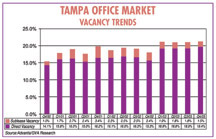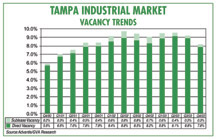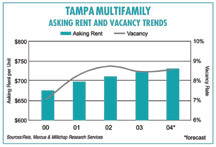| TAMPA’S
JOB GROWTH WILL IMPROVE REAL ESTATE OUTLOOK
A bright economic forecast follows projected employment growth
in the Tampa, Florida, area. The MSA is expected to gain 30,000
jobs this year, an increase of 2.4 percent. By 2006, the area’s
job growth is expected to measure a 9.6 percent increase over
2003. These new jobs will help fill office vacancy, currently
at 20 percent, including sublease space; and they will improve
the industrial market, which is currently experiencing a direct
vacancy rate of less than 8 percent. The increase in jobs will
also help to fill local apartment communities and per-unit sales
prices will continue to increase. Retailers are also taking
note of the projected growth; they have more than 20 million
square feet of retail developments on the drawing boards.
Office
 Crescent
Resources is nearing completion on the sole multi-tenant office
project under construction in Tampa. Corporate Center Three
at International Plaza, containing 287,000 square feet, will
be ready for occupancy this summer. This building currently
has 55 percent of its space committed. Crescent
Resources is nearing completion on the sole multi-tenant office
project under construction in Tampa. Corporate Center Three
at International Plaza, containing 287,000 square feet, will
be ready for occupancy this summer. This building currently
has 55 percent of its space committed.
Most office projects on the drawing board are planned for the
Westshore and Interstate 75 corridor submarkets; however, no
start-ups are expected in 2004 without significant pre-leasing.
2003 started with a spike in vacancy due primarily to the closing
of the 820,000-square-foot WorldCom/Intermedia campus as a result
of bankruptcy proceedings. Tampa’s overall vacancy rate,
including sublease space, remained stabilized at slightly more
than 20 percent over the course of the year.
Demand for office space was down in 2003 and many lease transactions
involved relocation or consolidation of existing tenants in
the market. One significant new deal was signed at a former
PricewaterhouseCoopers training facility in the Westshore submarket.
International Academy of Design & Technology consolidated
its local operations and leased the entire 130,000-square-foot
building. Net absorption will gradually improve during 2004
as business hirings gain momentum.
Over the past 3 years, the overall average asking rental rate
for Tampa office space has fluctuated in a narrow band around
$19 per square foot. Rates will bounce back as increased demand
reduces the space options for tenants. Rates in the Westshore
business district will rebound first, probably in the latter
half of 2004.
The Tampa area is well positioned for a resurgence of real estate
activity in 2004 and beyond. Economy.com projects employment
growth for the Tampa metro area from 2004 through 2006 to be
9.6 percent. This ranks the Tampa area as the 10th fastest growing
market in the nation. Job growth, especially in business services,
will positively impact Tampa’s office activity in 2004.
— Randy Smith, director of research, Advantis/GVA
Industrial
 Speculative
development in 2003 was limited to smaller projects, generally
rear-load flex buildings, which were adaptable for office
use and higher parking densities. Trammell Crow Company, EastGroup
Properties and First Industrial Realty Trust each dipped their
toes back into the market with new spec deliveries during
the year. Speculative
development in 2003 was limited to smaller projects, generally
rear-load flex buildings, which were adaptable for office
use and higher parking densities. Trammell Crow Company, EastGroup
Properties and First Industrial Realty Trust each dipped their
toes back into the market with new spec deliveries during
the year.
In December, Trammell Crow Company broke ground on a unique
inter-modal industrial development, which offers wharf and rail
access at the Port of Tampa. The first phase of the Port Ybor
project will feature a 282,000-square-foot cross-dock facility
to be completed in August.
New construction start-ups are scheduled for this year, primarily
on the east side. Duke Realty Corporation is building its eighth
building at Fairfield Distribution Center. Construction began
in January with completion of the 94,000-square-foot rear-load
structure slated for July. Also on the east side, EastGroup
Properties is scheduled to begin Palm River South in March.
This will feature twin 80,000-square-foot rear-load distribution
buildings with 150-foot depth. Target completion date for the
first building is this August.
Vacancies in Tampa’s industrial market started rising in
2001, but peaked by mid-year 2003 with a direct vacancy level
of 9.1 percent. The second half of 2003 finished strong, dropping
the direct vacancy rate to 7.8 percent by the end of the year.
Industrial demand got off to a slow start in 2003, but finished
with a strong surge in the second half of the year with 773,000
square feet in positive net absorption. The Eastside submarket
captured a majority of the larger deals, typically in the 40,000-
to 50,000-square-foot range, and accounted for about 85 percent
of the total net absorption for the year.
The overall average asking rental rate for industrial space
in Tampa remained relatively stable throughout the year. For
flex space, which represents less than 20 percent of total vacancy,
the average rental rate showed a significant gain for the year.
It rose 8 percent over the past 12 months, to close the year
at $7.77 per square foot. The average for distribution space,
which makes up the bulk of the market, ended essentially unchanged
from the start of the year, at $4.22 per square foot.
The outlook is positive for the industrial sector. According
to a new report prepared for the National Association of Wholesale-Distributors
titled “NAW Economic Forecast 2004,” Florida will
be among the leading states in the nation for employment growth
among wholesale distributors; the report forecasts 3.5 percent
growth in hiring.
— Randy Smith, director of research, Advantis/GVA
Retail
Florida has always had huge growth from in-migration following
periods of national crises, severe winters and economic downturns
such as the events that were ushered in with the tech bust in
mid- to late-1999. As residents move north and south of the
city of Tampa, retailers are not far behind. Most of the proposed
retail development in Tampa is to take place in high residential
growth areas, with southeastern Pasco County, New Tampa and
north/northeast Hillsborough County leading the way. These areas
exploded in the mid-1990s with single-family and multifamily
residential but had few retail options. Now retailers are scrambling
to serve; qualified developers have more than 2 million square
feet of retail space on the drawing boards with plans to be
significantly engaged in predevelopment activity this year.
Oakley Plaza at the intersection of SR 54 and I-75 will be the
largest undertaking. Echo Development will build a planned 1
million-square-foot regional center, which should open fall
2006. Just a few minutes’ drive from Oakley Plaza, The
Goodman Company will develop the new 400,000-square-foot Wiregrass
Ranch Power Center. Wiregrass Ranch is also breaking ground
on a 14,000-unit subdivision. The Wesley Chapel/New Tampa neighborhood
has a Wal-Mart Supercenter and SuperTarget, but Wal-Mart continues
to grow, adding another Supercenter near the busy intersection
of SR 54 and Bruce B. Downs Boulevard on Porter’s Wiregrass
Ranch. Wal-Mart is planning a Sam’s Club less than 4 miles
away, at the intersection of the new SR 56 and SR 581. Jacobs
also has plans to build a 1.2 million-square-foot conventional
enclosed mall at the intersection of SR 54 and SR 56.
Another area of substantial residential growth is south Hillsborough
County where young couples have created demand for housing.
Retailers want to be there to take advantage of the new demand
for goods and services. Morin Development and The Sembler Company
plan a major power center at the intersection of I-75 and Big
Bend Road. At Big Bend and U.S. 301, RMC Property Group is developing
a center for The Home Depot and Publix. Kash n’ Karry also
plans a new store on the southeast corner of the project.
In the Tampa Bay area, the story continues to be urban infill,
with such developments as Clearwater Mall, the Morin redevelopment
of the Jim Walter building at I-75 and Dale Mabry, and the explosive
growth of north/ northeast Tampa-southeast Pasco.
— Jeremy Kral, director of market analytics &
GIS, Colliers Arnold
Multifamily
 With
projections for strong employment growth and reduced construction,
Tampa’s multifamily market is poised for solid growth.
The Tampa MSA is set to record 2.4 percent employment growth
in 2004, a gain of 30,000 jobs, following a 1.5 percent payroll
expansion in 2003. Half of the new positions will be in the
professional and business services sector, which will fuel
demand for apartments as the market for first-time homeowners
begins to lose steam. With
projections for strong employment growth and reduced construction,
Tampa’s multifamily market is poised for solid growth.
The Tampa MSA is set to record 2.4 percent employment growth
in 2004, a gain of 30,000 jobs, following a 1.5 percent payroll
expansion in 2003. Half of the new positions will be in the
professional and business services sector, which will fuel
demand for apartments as the market for first-time homeowners
begins to lose steam.
Investors have taken notice, pushing up the median price per
unit among Tampa multifamily investment sales from $46,000 in
2002 to $48,000 in 2003. Sales activity has been stronger in
Hillsborough County than Pinellas County with the former accounting
for 60 percent of the metro area’s sales. A limited availability
of land helped the South Pinellas submarket post a median price
gain of 6.6 percent in 2003, to $52,500 per unit. Hillsborough
County’s median price per unit rose from $37,500 in 2002
to $44,000 in 2003. Areas closer to employment centers, such
as the Tampa CBD and Westshore, will record price gains over
the next 2 years as employment grows.
Apartment operators can expect vacancy to rise to 8.4 percent
in 2004, just 10 basis points above the 2003 level of 8.3 percent.
Vacancy climbed from 8.6 percent in 2002 to 9.6 percent in the
first quarter of 2003 but retreated rapidly later in the year
as employment escalated. Asking rents are expected to continue
climbing in 2004, from $722 per month to $731 per month, an
increase of 1.2 percent. Effective rents were flat in 2003,
at $660 per month, but are expected to rise this year.
Construction declined in 2003, and 2004 will see only 3,500
new apartment units. Heavy construction in the large North Hillsborough
submarket, however, resulted in a 5 percent increase in local
inventory and a jump in vacancy of 240 basis points. Selected
properties may be affected by new deliveries, presenting opportunities
for acquisition and repositioning.
— Steven Ekovich, first vice president and regional
manager, Marcus & Millichap’s Central Florida offices
©2004 France Publications, Inc. Duplication
or reproduction of this article not permitted without authorization
from France Publications, Inc. For information on reprints
of this article contact Barbara
Sherer at (630) 554-6054.
|
